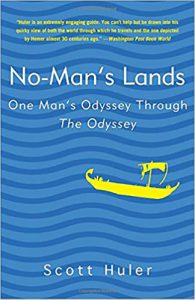No-Man’s Lands: One Man’s Odyssey Through The Odyssey, by Scott Huler
No-Man’s Lands: One Man’s Odyssey Through The Odyssey
Scott Huler
Crown Publishers
Four stars
Reviewed by Jessica Gribble
No Man’s Lands takes us on a journey. In fact, it takes us on a journey that’s so long and arduous and well known that it’s become the namesake of an impressive journey: an odyssey. Scott Huler’s book is about both The Odyssey, by Homer, and an odyssey of his own. We learn early on that Huler swore on NPR never to read James Joyce’s Ulysses, which is a modern retelling of Homer’s Odyssey. Ulysses is an obsession with its fans, but after several tries, Huler found it unreadable. After joining a Ulysses reading group—ah, delicious irony—he also decides to reread the real Odyssey. When Huler delves in, he discovers that he won’t be rereading at all—he’s never read the book, although he’s been claiming that he has since high school. He has some memories of important stories, like the Cyclops, Scylla and Charybdis, and the Sirens, but those clearly come from “common knowledge.”
Because Huler is a writer and a person who develops great passions for random topics (including NASCAR, the Cleveland Browns, and the Beaufort Scale), he begins to read and reread The Odyssey. He discovers that he’s about Odysseus’s age—44—and he’s facing an important life journey already; his wife June is pregnant with their first child. He reads some more and decides to take a long trip—after all, he has nine months until he’s needed at home. He’ll follow Odysseus’s footsteps through the Mediterranean. This involves a lot of physical traveling, but it also involves a lot of research. Almost everything about The Odyssey is debated by scholars, including the author (was it Homer? Was Homer blind? Was it really a woman?) and whether the story has any physical truth at all. It certainly has a lot of mythical elements: the Cyclops story that contributes to Huler’s title is one of the best known. Odysseus tricks the Cyclops by saying that his name is “No Man.” When the Cyclops cries to his neighbors that “No Man is killing me!” they understandably ignore him and Odysseus eventually escapes
This is a book of parallel journeys: the physical and the emotional. Scott Huler follows Odysseus’s path through the Mediterranean, so we can read the book as a travel narrative. There are some recurring themes—ferries to small islands, cheap food, information sought in several broken languages at once, and an amusing thread of unsuccessful boat rentals. Huler is good at sizing up and describing people even when he can’t understand what they’re saying. He’s good at plumbing the depths of his soul to determine what he’s feeling—frustration? Elation? Boredom?—and then applying some of the life lessons Odysseus learned to his own travels. (Respect the gods, in the form of capricious fate. Put family first. If you can’t trust yourself to do the right thing, get friends to help you.) When he’s really inspired by something, he can be a beautiful writer, as in the story of his visit to the crypts at the Chiesa di Santa Maria della Concezione in Rome, which are both creepy and sacred. Sometimes, however, the writing is just serviceable and the stories feel repetitive. A very nice interior design includes quotes from an English translation of The Odyssey, and readers will learn a lot from Scott Huler’s research into sources like the Tao Te Ching and Joseph Campbell’s The Hero with a Thousand Faces, among many others. No Man’s Land is long, preachy, and boring in places, and fresh, funny, and inspiring in others. In other words, it’s a lot like Homer’s version of the story.
